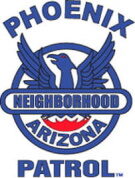NOTE : This page is a work in progress. The main idea is present, but details and some menu references, are not complete.
PNP member volunteers are requested to suggest content and info for this page as needed.
If you have ideas that can improve this, or any other page or part of this site, please contact us, see Admin email address below.
Our Phoenix Police Department’s Chief and our Phoenix City Council have placed additional and stronger emphasis on “Community-Policing” and since Phoenix Neighborhood Patrol (PNP) members are trained as Community-Policing specialists; you as trained PNP members are recognized as the key individuals in this plan.
- When reporting a crime to 911 or Crime Stop, be a good witness, be prepared to give as much accurate information as can be available;
- Who are you
- What did you witness,
- Where are you, and
- Where is the crime event you witnessed?
Example: I were to witness a crime in progress, I would say (I’ll use myself as an example), “My name is Jerry Cline, I am a trained Phoenix Neighborhood Patrol member, my badge number is 887 and I live in beat 635.” The operator will treat you with special consideration, because they know you are a specialist fighting crime in your neighborhood, and they know where your neighborhood is! Call 911 or 602-26-26-151 anytime and report when you feel you have witnessed.
To make this work, we all need to know and be aware of where we are in our respective police precincts and city council districts. To assist in this effort as professionals, we all need to know where we are on our respective Phoenix Police Department’s (PPD) maps, and the Council Districts’ maps.
The Police Department mapping system:
The PPD thinks and operates within what they refer to as a “grid system”. While we all normally think in terms of a street address system, when PPD needs to identify a person, and to understand where they are within their system, officers think in terms of: Precinct + Squad Area + Beat Area, which to them is “The Grid”. Where civilians may think of a neighborhood area, such as Sunnyslope, Arcadia, Maryvale, or a “Zip Code”, but the locator for the police is the beat area’s number. The Beat is of “office” where patrol officers work.
Phoenix is divided into eight Police precincts, each with an individual name and number. To download your precinct map*, click the precinct map above and locate the area that applies to you:
North: 200 Black Mountain
Southeast: 400 South Mountain
Central: 500 Central City
Northeast: 600 Desert Horizon
Central north: 700 Mountain View
Southwest: 800 Maryvale (300 Estrella is now part of 800)
Northwest: 900 Cactus Park
While all precincts are very much the same, there may be small differences, but the following is generally correct.
Each precinct is divided into three general geographic areas referred to as “Squad Areas”, and each squad area is divided into five Beat Areas.
Considering the three (squad area) divisions, each has a number, as an example, Desert Horizon Precinct’s number is 600. Each squad area is numbered 1, 2 & 3, and each of the five beats inside a squad are numbered 1 through 5.
Keep that in mind while looking at your precinct map, noting the three squad areas, locate the one within which you live. Then locate the beat area within that squad area. The combination of the three numbers identifies your beat area. In my example, I live in Precinct 600, squad area 3, and beat area 5 so my beat is 635.
Why would Phoenix Phoenix PD want to know where you are?
Sergeant Dwyer said, “We are looking to the specialists, the PNP trained members, the premium and primary neighborhood folks, the members who care and who can stop crime in their neighborhoods. Their special PNP training is imperative to us as a tool to stop crime! They are the ones in their neighborhood to whom the police will turn to for immediate assistance with crime and suspect information.”
“The Phoenix Police, relate to crime mapped on their grid, and when they alert the PNP members in their beat area, members with beat numbers will be contacted with alerts as needed. They will communicate relevant details to make you aware and be on the lookout; the reason is obvious!” PNP members are the best crime fighting tool in their neighborhood because there is no other person who knows your neighborhood as they know their neighborhood, and they are trained to report and know to NOT get involved! They just back off and report! They are the knowledgeable local patrolman, that augment and multiply the their beat patrol – a valued resource!”
We all just need to learn a little “police-speak” so we can communicate with them as to where each of us are located on their grid.
About privacy
Since a beat area is large, some examples are comparable to Zip Code size, giving your beat information is generic, not invasive to you. However, as noted, the beat number is the recognized number by the police as a place where their patrol officers are assigned to work.
If your beat area was experiencing crime, the beat patrol officers know where the crimes are happening on the grid, and if you could be alerted to be aware of certain specifics, you are a valued multiplier to your beat patrol officers.
You can check with your website PNPMembers.com to learn more about your patrol personnel and their beat areas as well as your community action officers (CAO).
Your City Council members
Your city council member is also strongly supportive of Community-Policing and they are assisting in the recognition of PNP and block watch.

